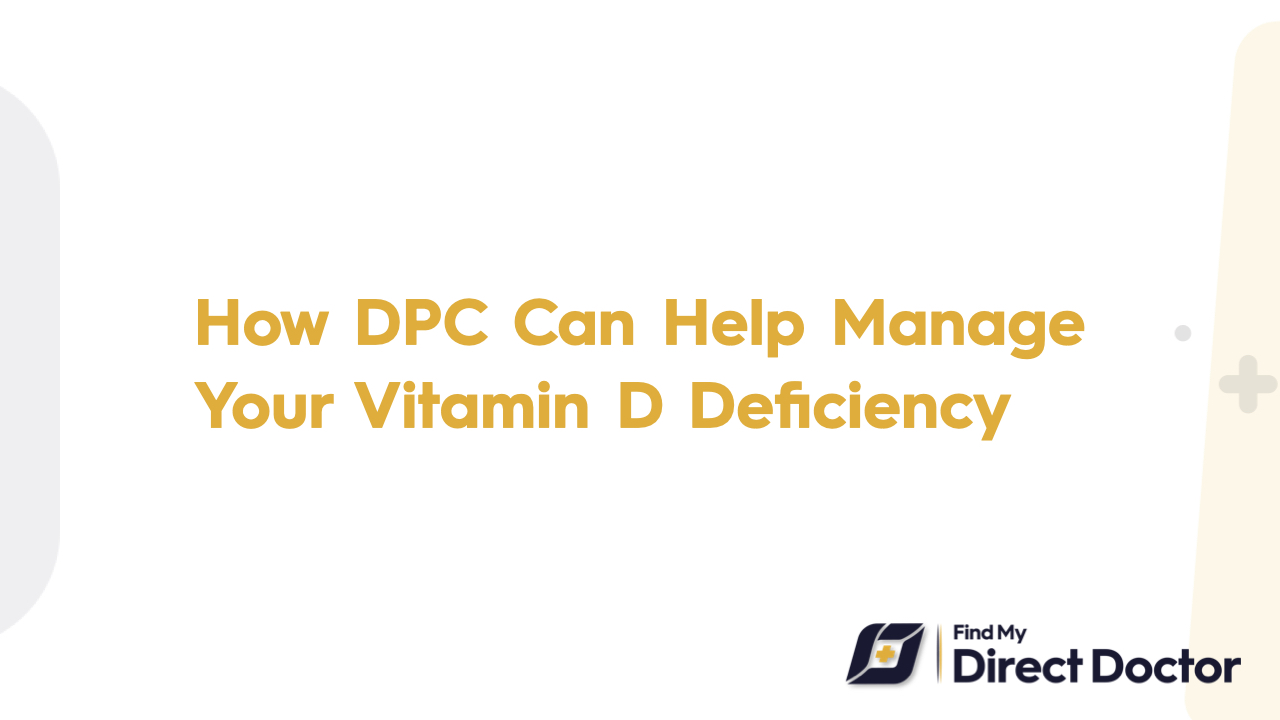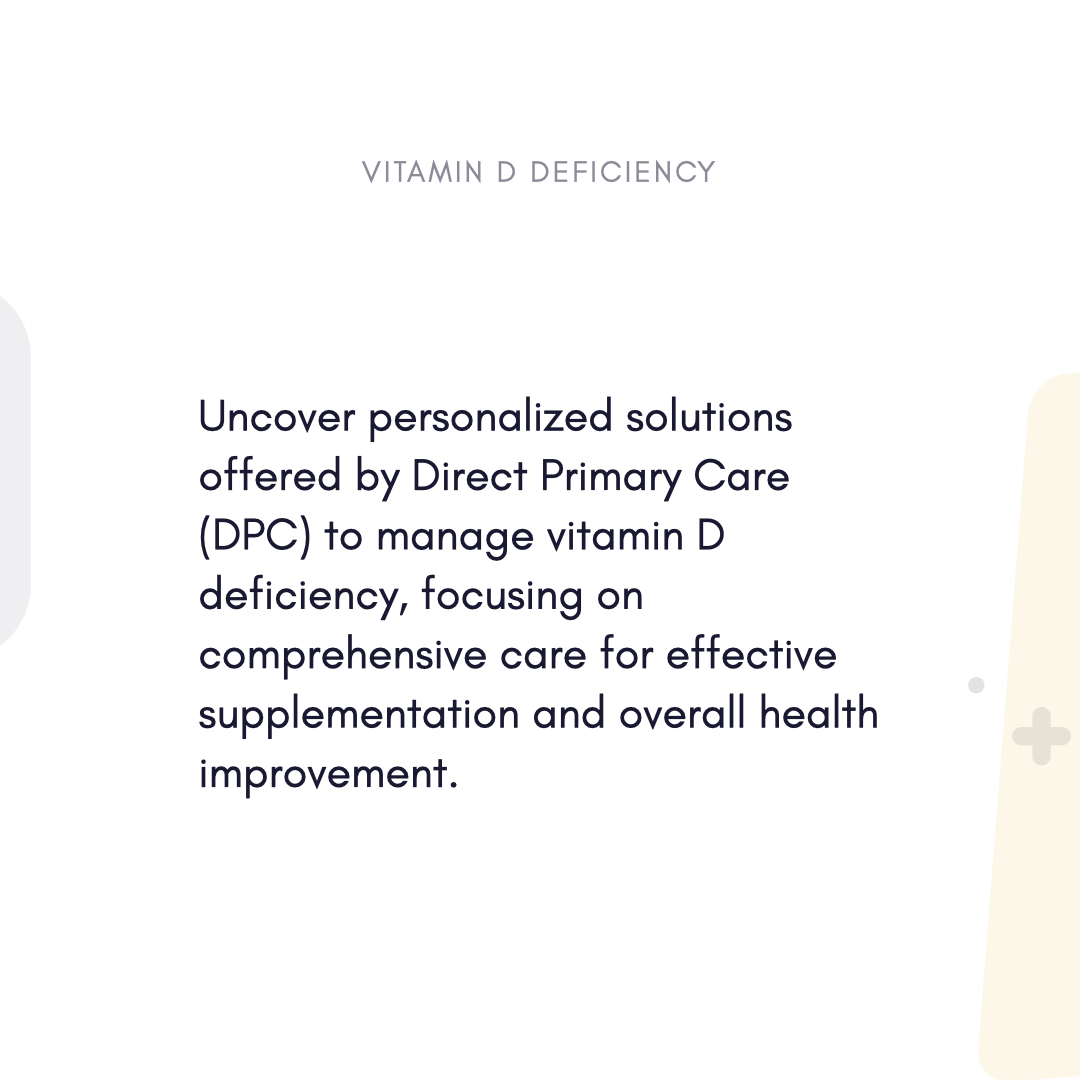Vitamin D Deficiency and Direct Primary Care (DPC): Personalized Path to Optimal Levels
If you have battled low vitamin D-related tiredness, bone pain, or frequent infections, you know how this "sunshine vitamin" deficit can compromise your health. Affecting 42% of Americans, inadequate vitamin D influences immune system, mood, and bone strength. Direct Primary Care (DPC), which combines accurate testing, customized supplements, and techniques to maintain optimal levels, presents a proactive, patient-centered method of vitamin D management, however.

Appreciating Vitamin D Deficiency and Its Effects
Serum 25(OH)D less than 20 ng/mL causes:
- Osteomalacia and osteoporosis.
- Depression and weakness of the muscles.
- Raised risk of infection.
Risk factors include:
- Obesity, dark skin, little sun exposure.
- Malabsorption (Crohn's disease, celiac).
DPC Changes Maintenance of Vitamin D
Under the membership model known as Direct Primary Care (DPC), patients pay a monthly fee—usually 50 USD–150 USD—for unrestricted access to their primary care physician. For those with vitamin D, this translates into no surprise bills, no waiting weeks for test results, and treatment geared at restoring your vitality.
Here's why DPC distinguishes itself:
1. Exact, guided, rule-driven testing
DPC doctors adhere to AACE/ACE recommendations including:
- Baseline 25(OH)D testing: For patients at risk.
- Parathyroid hormone (PTH) checks: If deficiency is severe.
- Bone density scans (DXA) for osteoporosis or osteopenia.
2. Reasonably priced, customised supplements
- Offering high-dose D3 (50,000 IU) at 5 USD/month instead of 30 USD+ retail helps DPC clinics cut costs.
- Maintenance D3 (2,000 IU) at wholesale rates.
- Using ideal dosing to prevent pointless repeated labs.
3. Ongoing Education & Surveillance
- Having 24/7 access to your DPC doctor allows you to change dosages depending on follow-up tests.
- Find sun exposure best practices (10 to 30 minutes midday).
- View dietary guidelines (fortified foods, fatty fish).
DPC Benefits for Vitamin D Patients
Customized Treatment Plans
- Each visit, DPC doctors spend 30 to 60 minutes developing plans including:
- Loading phases: Six to eight weeks of high-dose D3.
- Co-supplementation: D activation requires magnesium.
- Changing for obesity (D stored in fat) weight-based dosing.
Money Saving
- There is no co-pays for many lab visits.
- With insurance, DXA scans at 150 USD rather than 500 USD+.
- Avoidance of fractures under early correction for early deficit.
Integration of Holistic Health:
DPC attends:
- Zinc for immune support; vitamin C to prevent infections.
- Mental health: tackling low D-linked depression.
- GI health: Control of malabsorption problems.
Stories from Real-Life Success
- Case 1: Using DPC's program, 35-year-old Sarah raised her D from 18 to 45 ng/mL in three months, so addressing her chronic fatigue.
- Case 2: John, 60, used DPC's D3 + weight-bearing exercise program to prevent osteoporosis.
Frequently asked questions: DPC and vitamin D deficiency
- Q: Can I get enough D from just sunlight?
- A: Perhaps, but DPC tests levels to guarantee sufficiency—particularly in northern climates.
- Q: For long-term management, is DPC reasonably priced?
- A: Agreed. Members save labs and supplements 50–70%.
- Q: Given kidney disease, what would happen?
- A: A DPC tracks calcium/phosphorus and, if necessary, makes use of active D (calcitriol).
Why DPC Benefits Those With Vitamin D Deficiency
Keeping 25(OH)D ≥30 ng/mL is stressed by the Endocrine Society. DPC presents this via:
- Early identification of inadequacies: standard screening for high-risk groups.
- Empowering patients: Sun, diet, and adherence education
- Cost simplifying: There is one monthly cost covering all coordination and monitoring.
Use DPC to reclaim your vitality.
Deficiency of vitamin D does not have to compromise your health. Every test, every supplement, every beam of progress—every partner you acquire with DPC fine-tunes, educates, and prioritizes your well-being.






